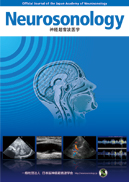巻号一覧

27 巻 (2014)
- 2-3 号 p. 69-
- 1 号 p. 1-
27 巻, 2-3 号
選択された号の論文の4件中1~4を表示しています
- |<
- <
- 1
- >
- >|
目で見る神経超音波診断
-
上野 祐司, 卜部 貴夫, 服部 信孝原稿種別: 目で見る神経超音波診断
2014 年 27 巻 2-3 号 p. 69-70
発行日: 2014/12/31
公開日: 2015/01/29
ジャーナル フリーPDF形式でダウンロード (906K)
原著論文
-
大吉 貴文, 徳永 祐希子, 大友 純, 前川 謙悟, 馬場 知子原稿種別: 原著論文
2014 年 27 巻 2-3 号 p. 71-75
発行日: 2014/12/31
公開日: 2015/01/29
ジャーナル フリーObjectives: Systemic atherosclerosis is frequent in elderly patients with degenerative valvular aortic stenosis, and it can predict postoperative cognitive dysfunction (POCD). Arterial stiffness, measured by brachial-ankle pulse wave velocity (baPWV), was evaluated as a predictor of POCD in patients undergoing aortic valve replacement (AVR).
Methods: Data were collected on 95 AVR patients (age 74 ± 6 y), who were divided into two groups, with and without POCD. Risk factors and baPWV were compared between the two groups, and the probability of POCD was calculated.
Results: POCD occurred in 30 patients (32%). POCD patients had significantly higher baPWV (1500 ± 300 vs 1284 ± 254 cm/sec), lower estimated glomerular filtration rate (eGFR)< 40 ml/min/1.73 m2 (50% vs 15%), more severe white matter lesions (30% vs 6%), and lower preoperative scores on cognitive tests (Digit Symbol Substitution test 23 vs 29, Kana pick-out test 13 vs 19). The probabilities of POCD with baPWV > 1470 cm/sec, eGFR ≤ 40 ml/min/1.73 m2, and Digit Symbol Substitution test score ≤ 30 or Kana pick-out test score ≤ 18 were 0.78 and 0.80, respectively.
Conclusions: Arterial stiffness is independently associated with POCD following AVR. baPWV appears to be useful to predict POCD when combined with eGFR and scores on preoperative cognitive tests.抄録全体を表示PDF形式でダウンロード (925K)
症例報告
-
田中 陽平, 小澤 哲夫, 中島 孝, 岡本 竹司, 榛沢 和彦原稿種別: 症例報告
2014 年 27 巻 2-3 号 p. 76-79
発行日: 2014/12/31
公開日: 2015/01/29
ジャーナル フリーReversible cerebral vasoconstriction syndrome (RCVS) is characterized by acute thunderclap headaches with or without other neurological symptoms, and reversible multi-segmental vasoconstriction of the cerebral arteries. We describe the case of a 49-year-old woman presenting with severe, sudden-onset headaches and multi-segmental vasoconstriction of the cerebral arteries demonstrated on magnetic resonance angiography (MRA). Headaches disappeared within several days, and vasoconstriction of cerebral arteries was markedly improved 6 weeks after the onset. We therefore diagnosed RCVS. In addition to MRA, we repeatedly performed transcranial-color flow imaging (TC-CFI) and transcranial Doppler ultrasonography (TCD) to evaluate cerebral arterial blood flow and risk of cerebral infarction. The first TCD study was performed 6 weeks after the onset; 11 high-intensity transient signals (HITS) were detected in 30 min at the region of vasoconstriction in the right MCA. To the best of our knowledge, this is the first report of HITS-positive RCVS. Ten weeks after the onset, MRA demonstrated disappearance of cerebral arterial vasoconstriction, and TCD detected only 1 HITS in 30 min. Interestingly, TC-CFI still indicated elevated flow velocity in the bilateral MCAs. These findings suggest that TC-CFI may be more sensitive and useful than MRA for diagnosis of RCVS.抄録全体を表示PDF形式でダウンロード (3085K)
-
2014 年 27 巻 2-3 号 p. 80-95
発行日: 2014/12/31
公開日: 2015/01/29
ジャーナル フリーPDF形式でダウンロード (1602K)
- |<
- <
- 1
- >
- >|